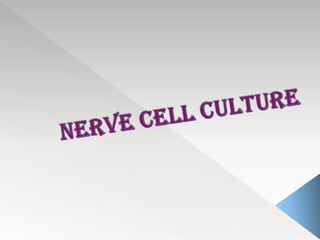
Neuronal culture
- 2. By isolating differentiated cell or tissue for short term nonregenerative cultures Isolating precursor cells Stem cell culture
- 3. FASTIDIOUS Neurite outgrowth is encouraged by a polypeptide nerve growth factor Neurons used are hippocampal, cortical, spinal, cerebellar etc Disadv : long term culture diffficult
- 4. COATED PLATES- POLY L LYSINE OR COLLAGEN NGF GLIAL FACTORS PROTOCOL CONTRIBUTED BY BERNT ENGELSEN AND ROLF BJERKVIG
- 6. DMEM with › Glucose 30mM › L- glutamine 2mM › KCl 24.5mM › Insulin 100mU/L › P- amino benzoic acid 7μM › Gentamycin 100μg/ml › Fetal calf serum 10%
- 7. Dissect cerebella aseptically and place in HBSS Mince to 0.5 cubic mm Wash with HBSS three times Trypsinisation Add growth medium: stop the action of trypsin Trituration to obtain single cell suspension
- 8. Centrifuge at 200g for 5 min.. Resuspend the pellet in growth medium and seed the cells at a conc of 2.5- 3×106 cells/plate After 2-4 days incubate the culture with 5-10μM cytosine arabinoside for 24 hrs Change to regular culture medium
- 9. Neuron specific enolase antibody Tetanus toxin marker Glial fibrillar acidic protein for astrocyte contamination
- 10. 3 TYPES › ASTOCYTES › MICROGLIAL › OLIGODENDROCYTES Human adult normal astroglial lines from brain lines express glial fibrillary acidic protein
- 11. DMEM containing › Glucose 25mM › Gentamycin 25 μg/ml › BSA pathocyte 0.0286% › Glutamine 2mM › Bovine pancreas insulin 10μg/ml › Human transferrin 100 μg/ml › Progestrone 0.2 μM › Putrescine 0.10 μM › Selenium 0.224 μM › Triiodo thyronine 0.49 μM › Thyroxine 0.45 μM
- 12. PROTOCOL- OLFACTORY ENSHEATHING CELLS CULTURE Collect olfactory lobes Mince well Collaginase treatment for 30-45 min at 37°C Centifuge 100g 5 min Resuspend pellet in Ca and Mg free HBSS Centrifuge and culture 5×106 cells/ml of DMEM
- 13. Labelling with galactocerebroside to distinguish betweeen OEC and oligodendrocytes Done prior to cell plating Primary antibody O4 and secondary antibody anti-GalC
- 15. Isolate cerebrum Peel off the meninges and transfer cortex to a tube containing cold dissection buffer placed on ice Pour tissue into a dish and wash with modified DMEM/F12 culture medium with 10% FBS, 1% glutamine, and gentamicin Mechanically disintegration Trypsinization and DNase treatment- Incubate at 37ºC for 25 minutes.swirl tube every 5 minutes Wash tissue with Glial Medium twice Dilute suspended cells in 10 mL of Glial Medium, and pass the solution through a 40 uM strainer Centrifuge cells at 1700 rpm for 5 minute Resuspend pellet with 10 mL Glial Medium Seed 2 x106 cells/T75 in 15 ml Glial medium Incubate the flasks at 37oC in 5% CO2 for 2-3 days without disruption. Change the medium in each flask every 2-3 days by aspirating and adding 15 mL fresh Glial Medium until confluency is achieved (after approximately 6-7 days)
- 16. Once the primary cultures are confluent, change the medium and tighten flask caps. Wrap flasks in plastic and place on shaker platform horizontally with medium covering the cells Shake at 350 rpm for 6 hours at 37°C to separate oligodendrocytes from astrocytes Change medium (10mL) and replace flasks on shaker for 18 more hours Remove flasks from shaker, and aseptically pour contents into a new T75. Incubate Change medium in flasks (10mL), tighten caps, cover in plastic, and shake, again, for 24 more hours (change medium in 6 hr) Aseptically pour contents into a new T75 and incubate until confluent Reseed at 3 x 105 cells in each T75 flask fresh culture must be prepared every three weeks
- 17. Passage Sterilize petri dishes by coating with 1 mg/ml of PureCol Collagen, washing with sterile ddH20, and allowing to dry in culture hood for 30 minutes The next day. wash glial cells with PBS once Add 3-5 mL of trypsin to the culture flask; incubate at 37°C for 5 minutes Add 5-7 mL of Glial Medium to the culture flask, and then transfer cells to a 50 mL tube Centrifuge cells at 1700 rpm for 5 minutes Remove the supernatant and resuspend the cells in 10 mL of Glial Medium Seed cells at 7.5 X1O4 cells/6cm dish in 6mL Glial Medium.
- 20. to study the membrane properties of Schwann cells axon-Schwann cell communication how these alter in neuropathic conditions to use Schwann cells for the repair of lesioned peripheral nerve to exploit their potential for regeneration in CNS lesions.
- 22. o USE AS A MODEL Advantages Neuronal activity in controlled env Observation possible at several points and methods Disadvantages Inter Connectivity is lost Lacks body PATHOLOGICAL STUDIES CELL BASED THERAPIES › Glial cell used in spinal cord injuries
Notas do Editor
- .o25% trypsin for 15min at 37
- Inhibits the growth of other cell types